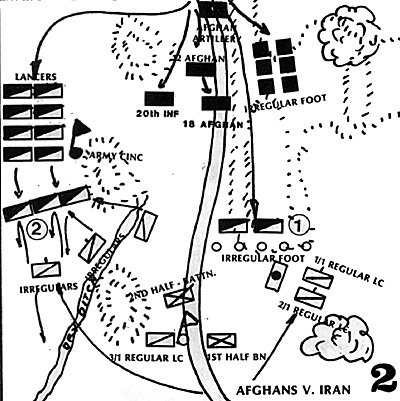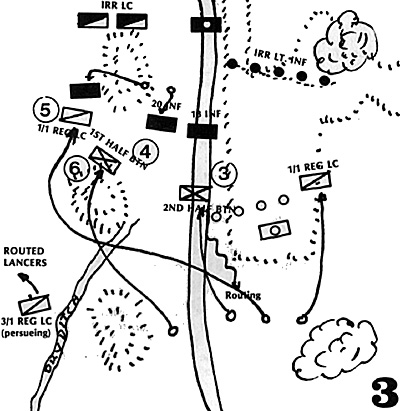Our next test Scenario is set in western Afghanistan in the 1870's. It assumes simultaneous attempts by the Royal Army of Afghanistan and the Army of the Shah of Persia to conquer and hold Turkestan. The two regular armies come into conflict as rival expeditions skirt the borders of the last Khanates. This mythical Iranian Army is patterned after the reformed Ottoman Turkish Army of the period, while it is assumed that the House of Krupp has equipped and advised the Afghanistanis.
Afghan Order of Battle
-
20th Afghanistani Line 24 figures (Paper Breechloader) Regular
18th Afghan Line 24 figs (Paper Breechloader) Regular
Irregular Militia 12 figs (Roundball Rifle) Green *
12th Afghan Line 12 figs (Paper Breechloader) Regular
1st Afghan Lancers 24 figures (Lance, Paper BL Carbine) Elite
Iranian Order of Baffle
-
1st Nizam (Line) Battalion
1st Half Battalion 24 figs. (Paper Breechloader) Regular
2nd Half Battalion 24 figs. (Paper Breechloader) Green
5th Regular Cavalry (Light Cavalry)
4th Squadron 6 figures (Paper BL, Sabre) Elite
5th Squadron Same as above, except Regular
6th Squadron Same as above, except Elite
Iranian Irregular Light Horse *
1st Squadron 9 figure, Lance, Sabre Green
2nd Squadron 6 figure, Lance, Sabre Green
Iranian Irregular Infantry 9 figures (Roundball Rifle) Raw
Regular Artillery: 1 section, 2 guns (12 lb Smoothbores) Regular
Note: each force had an Advance Guard (*) and Main Body, under separate Commanders.
Victory Conditions were similar to Scenario One. Each force deployed within 12" of the entry point, with its Advance Guard on board. The remainder of forces entered in road column along the track, and after one turn of entry could be ordered into position. After Turn 5, each Commander chose an Objective. Each chose to attack the enemy's left flank.
The Afghan Order of March was: 1st Lancers, 20th, 18th and 12th Line, Krupp Guns. The Iranians were Artillery, 2nd Half Bn., 5th Regular Lt. Cav., 1st Half Bn. The Afghan Advance Guard sent its Horse along the northern ridge line parallel to the road, in Open Order, supported by the Irregular foot on the rear of the hill mass. The Iranians moved up their Irregular foot to the first hillock to the right of the roadway, while the two Irregular lancer squadrons crossed the dry ditch at a walk and cantered up the left flank into an "U'. Meanwhile the artillery started off ata sedate pace toward the hilltop (neither commander yet realized the effects of fire down from a hillock). By turn 5, the positions as shown were realized.
- 1. Inadvertent collision of irregulars
2. Lancer charge, defeats 2 squadrons of irregulars, loses to 3/1 reg. I.c.
3. Long range artillery/rifle duel.
4. Long range infantry duel.
5. Death ride of 2/1 Lt. Cav.(screening 1st half battalion).
6. Confident volley into 2nd Inf., then 12th.
An unfortunate turn of affairs began the battle. Each side misjudged the distance travelled along the ridge top, and both Irregular lead elements collided (an Encounter, as neither had Charge Orders). We discovered that when neither side is in Close Order, a melee takes place. The Iranian foot had simply been standing, covering the limbered artillery trying to move up the gentlest part of the hilltop. Its opening volley shot 40 Afghans out of their saddle, shaking their morale and causing an automatic fall back. The morale of the Irregulars was, however, so bad that they too were shaken and fell back, but were soon rallied and took their place next to the guns.
The Afghan Cavalry next tried to advance, loosely supported by one infantry Battalion (the 20th) along their right (southern) flank. The Irregular lances set up to oppose their charge, which was made in double column of squadrons. The lancers faced about and moved at the gallop at an oblique to the northeast, while 2nd Squadron charged. A squadron of Regular Chasseurs was sent west to support the effort. Unfortunately the Afghans wheeled, overlapped and routed the Irregulars, but then were caught reordering by the fresh Chasseurs and routed in turn.
In this, the second game in a row in which this happened, we should like to make the point that a Cavalry regiment deployed in squadron/units is not only more historical, but vastly more tactically useful than a regiment deployed in a single regiment/unit. Squadron deployment allows the fledgling Cavalry Colonel to hold back a reserve, make multiple and/or flanking charges, and in general make a serious nuisance of himself - operations not available to his brother who maneuvers in bulk. The disadvantages: a serious vulnerability to fire and consequent ineffectiveness against infantry frontally, are relatively unimportant compared to the maneuver flexibility of single squadrons. Remember, however, that the recommended 7 unit limit (the number of units Mr. Grossman believes a single player can control easily) still applies, and the commander who uses squadrons is reducing the overall size of his force while increasing its efficiency.
While the action to the south was going on, 2nd Half Battalion generated a firefight with 20th Afghan, the Artillery, supported by the Irregular Riflemen, harassed 18th Afghan, and 12th Afghan began to move into supporting positions behind 18th and 20th. The Artillery on the Afghan side entered the board, but was left behind, limbered and forgotten, as its general took up personal direction of the forward battalions. (In this game, we were not really used to the idea of series of orders, and gave them one at a time.) The cumulative effect of the Iranian bombardment on the 18th Afghan showed the power of any tiny amounts of field guns. Each turn, the Iranians inflicted 12 casualties, cumulative with casualties inflicted by the Irregular riflemen (both Iranians and Pathans Irregulars were judged capable of improved open/extended order fire - a 50% increase in fire effect which made the old roundball rifles deadly), a total of 6 figures (120 men) hors de combat in 20 minutes (4 turns). The 18th was removed as a decisive force before it even engaged.
The battle's finish was reached when 1st Half Battalion advanced, screened by a squadron of Chasseurs whose Open Order death ride forced 12th Afghan to use its first fire. 2nd Half Battalion's firefight with 20th drew that unit's attention, and 1st Half Bn. slipped into the gap, Elite and Confident. Its first volley destroyed 20th Afghan, and its second ruined 18th, which had reduced from Confident to Firm without firing a shot (220 casualties against 20th, eliminating it, and 140 against 18th, which had sent its first two volleys against 2nd Half Battalion, completing the routing of the 2nd while Ist Half Battalion gained its position. The third volley inflicted 60 casualties on 1st Half Bn. in return, but that was small price to pay.
That left only 12th Afghan, with 220 men against 2nd and two squadrons of Chasseurs, plus the terrible Iranian Artillery. The Advance Guard was in hand again, but its two formations were of little use against the bulk of the Iranian Army. Neither side fulfilled its objective - the Iranian reaction to the Afghan threat had led to a complete reversal of plan and an attack up the center.
The second Scenario demonstrated several things: the decisive edge Squadron sized Cavalry have over Regiments; the relative inefficiency of small artillery units (less than a full battery); and the need to constantly plan control of one's units. The use of the Afghani C-in-C as a battalion leader (Follow Me Orders) deprived his brigade of central direction at a time when every unit was precious. Also the effects of firing up at hilltops was seen, but not appreciated (most of the later firing took place at ranges where the total slope from gun to target was 1:7 or more), partly because the Iranians were posted where the Afghans had no real opposing forces.


More The Complete Brigadier
-
The Complete Brigadier: Rules Overview
The Complete Brigadier: Scenario 1
The Complete Brigadier: Scenario 2
The Complete Brigadier: Tactical Notes
More Reviews
-
Ral Partha 25mm British Colonials (figures)
Stone Mountain 20mm ACW (figures)
Platoon 20 25mm modern (figures)
Fusilier Miniatures 30mm Napoleonic (figures)
Painting Services: Terry Sirk and Alatair Ltd.
Freicorps 15mm 7YW (figures)
Miniature Marvels 1mm 17th C. Pike and Shot (figures)
Minifig Napoleonics and Ancients (figures)
Attack and Die: ACW Tactics (book)
Armies of the Middle Ages (book)
Paper Soldiers: Crusaders and Their Foe
The Complete Brigadier 1680-1880 (rules)
Back to Table of Contents -- Courier Vol. IV #4
To Courier List of Issues
To MagWeb Master Magazine List
© Copyright 1983 by The Courier Publishing Company.
This article appears in MagWeb (Magazine Web) on the Internet World Wide Web.
Other military history articles and gaming articles are available at http://www.magweb.com